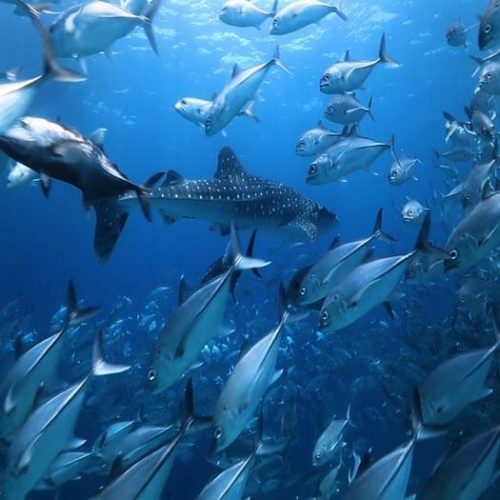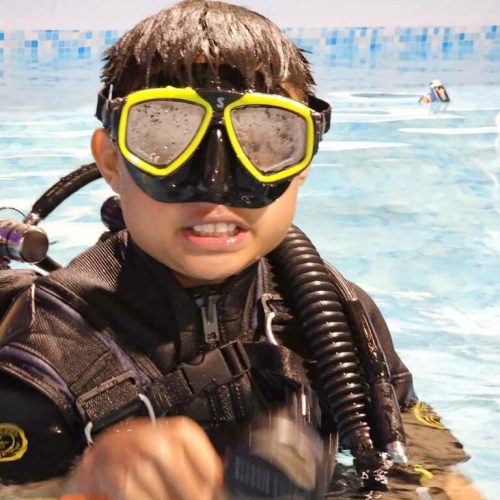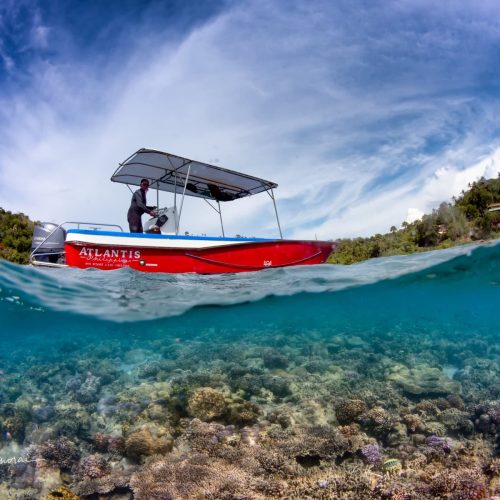Code of Conduct for Photographers & Videographers
BRING YOUR CAMERA – IF YOUR BUOYANCY IS GOOD
No-one should attempt to take pictures or film underwater until they are competent divers. Novices – and divers who do not possess superior buoyancy skills – thrashing about with their hands and fins will do untold damage without even noticing. Also, every diver should ensure that gauges, octopus regulators, torches and other equipment are secured. If we find that your photography damages the reef too much, we will ask you to stop.
DON’T MAKE CLOUDS OF SAND YOUR TRADEMARK
Needless to say, apart from damaging corals and critters and possibly yourself, you will make it impossible for other divers to see anything or take pictures when the swirling sand has reduced the visibility. Look behind you from time to time and assess your effect on the environment!
NO CAMERA ON YOUR FIRST DIVE
In a new environment, especially when you haven’t been diving for a while, your buoyancy might be a bit off. We therefore ask you not to bring your camera on the first dive of your stay. This gives you plenty of time to assess your skills, get orientated and get an idea about what to photograph the rest of your stay. If your Divemaster sees you with camera in hand during your first briefing, you will be asked to leave it until the next dive.
LEARN HOW TO BACKWARDS-FIN!
A Peak Performance Buoyancy course will teach you to dive and photograph without damage – knowing how to back away from a subject is an invaluable skill for photographers. Ask us about the course.
ONE CAREFUL FINGER BEATS KICKING CORAL
A finger placed carefully on a bare patch of rock can do much to replace other, more damaging movement like fin kicking kneeling down. Try and find subjects that allow you to photograph without damage.
NO GLOVES PLEASE
Gloves are not necessary in our warm water, and we will therefore ask you not to wear them.
DON’T STRESS THE FISH
Care should be taken to avoid stressing a subject. Some fish are clearly unhappy when a camera invades their ‘personal space’ or when pictures are taken using flash or lights. Others are unconcerned. They make the best subjects. If your Divemaster gauges that a critter has had enough and asks you to move away, please respect this.
NOT ALL CRITTERS ENJOY BRIGHT FLASHES
Queuing to photograph a rare subject, such as a pygmy seahorse or a ghost pipefish, should be avoided because of the harm repeated bursts of bright light may do to their eyesight. We have seen many blind pygmys. The number of shots of an individual subject should be kept to the minimum, especially if you have a small point-and-shoot camera since they tend to get very close. If your Divemaster sees that you are too close or spend too much time photographing a stressed out subject, he or she will ask you to move on.
THE FISH CAN FEED ITSELF
Divers should never kill or feed marine life to create a photographic opportunity, such as feeding sea urchins to a wrasse or bread to batfish. Don’t ask your Divemaster to feed the fish.
GET FINGERS OFF THEM!
Creatures should never be harassed to create a reaction nor should they generally be moved or touched. Do not touch, move or ask your Divemaster to move critters to make a better picture.
LET THEM SWIM OFF
Bigger fish and turtles tend to swim away when we come too close for comfort. If you are following a subject to get good photos or video, stop when you sense that the animal is trying hard to get away from you. It does it for a reason.
A POINTER POINTS, IT DOESN’T POKE
We do not encourage you to dive with a pointer. If you do, use it as a pointer, not to poke marine life or move things around.
BE CAREFUL AT NIGHT
Night diving requires exceptional care because it is much more difficult to be aware of your surroundings. Torch beams or lights can confuse and disturb fish if pointed directly at them. Be prepared to keep bright lights off subjects that exhibit stressed behavior, using only the edge of the beam to minimize disturbance.
OUCH! I SAT A SPIKY FISH..
We also ask you to avoid harming yourself. Many photographers opt to sit or lay down on the sand while taking pictures. As good as this is, watch carefully first because we have a lot of spiky animals hidden in the sand (demon stingers/devil scorpion fish etc) and they sure hurt. Some of our anemonies sting, as well as other seemingly harmless soft coral.
LOOK UP FROM YOUR SCREEN
Today, when so many more divers are taking up underwater photography, both still and video, it is essential that the preservation of the fragile marine environment and its creatures is paramount. We know that it is hard to keep your eyes off the LCD screen under water in the quest for that perfect picture, but please look up and ensure that this Code of Conduct is carefully observed.
Book to stay with Atlantis, and you can book with confidence, with Atlantis its all about quality and service, and they surpass themselves.
From your tastefully decorated, clean and bright rooms, to the kitchen, that prepares your meals from only the freshest of ingredients, the whole design is to keep you rested and relaxed so you can truly take advantage of the extremely knowledgeable dive teams, who will guide you through some of the best dive sites on the planet.
Atlantis offer exceptional value to the diver, and when comparing with other operators, its good to remember, that the bitterness of poor quality, remains long after the sweetness of a cheap deal is forgotten
Lydia LodgeUnited Kingdom (Oonasdivers)
The trip was absolutely wonderful! I don’t think your staff could have done much more for us to make us comfortable and make us want to return. Everyone had an absolutely fabulous trip at both properties.
Truxton TerklaUnited States of America
Thank you for a perfect time with you all at Atlantis. My first diving holyday ever was a huge success; Meeting all these wonderful people, having my advanced certification, diving every day, buying my first wetsuit, seeing the turtle, the wrecks, the corals, sharks, night diving, warm water, sun, heat, cooold beers?. I can’t wait for the next one to come!
Silvelin HavnevikNorway
Thank you again for a wonderful experience. The wait staff were always wonderful, personable and always remembering my name and what I like to drink. All of the divemasters were always attentive and knowledgeable. The entire front desk staff was always helpful in whatever request or question. I appreciated very much the personal touch that your entire administrative staff carried throughout the stay. You have a wonderful resort that I will definitely come back to soon.
Adi KleinUnited States of America
I just want to say WOW!!!! Thank you for taking such wonderful care of us. We all had a great time. Your staff is very professional, helpful and conscious of the details. They make sure the dives are safe and still provide a fun time, making sure divers at all levels and interest can accomplish their objectives. I am excited to see healthy reefs with no trash or damaged corals. The hotel was comfortable, relaxing, and well run.
Ann KeiblerUnited States of America
I am writing to send a HUGE THANK YOU to you and all the team at Dumaguete. Leon and I enjoyed the resort, the atmosphere and the fabulous diving. We had a wonderful time chilling out at the resort and enjoying the peace and quiet of your secret, hidden oasis!
Carole HarrisDubai UAE
I had such a great time at your resort. I will tell all of my friends about it and encourage them to visit. I travel quite a bit and usually want to return home after a week or so; however, after 10 days at your place, I hated to return. I actually stayed an extra day because I did not want to leave. So, thank you so much for a great vacation.
Joe BroylesUnited States of America
I want to thank everyone at Atlantis Beach Resort for their efforts in making the visit to both resorts one to remember for some time to come. The whole experience was quite enjoyable and trouble free, so much that I am having some difficulty readjusting to cold-water diving — nearly froze in 52 degree water at Monterey this weekend.
Steven ChungUnited States of America
I just wanted to let you know how much Jane and I enjoyed our stay at Atlantis. Your operation is professional in every respect and the staff is friendly, proficient at their jobs and motivated to provide superior customer service. We simply couldn’t have been more pleased with the experience (just wish the travel time there was shorter).
Gray & Jane LloydUnited States of America
Previous
Next
Special Offers
Dive into our special offers and enjoy Atlantis’ five star service at an incredible value!
Last Minute Liveaboard Availability
Dive this fall with our last minute special $600 Off plus 2 free nights at Atlantis Puerto Galera resort!
Bring Your Kids Diving For FREE
Through the end of 2024, kids under 18 stay, dine and dive at Atlantis for FREE! Family members 18-30 years enjoy 50% off! Non-divers can experience a Try Scuba FREE!
Dive Into Deep Discounts !
Enjoy great value on all inclusive stays now through the Fall!









